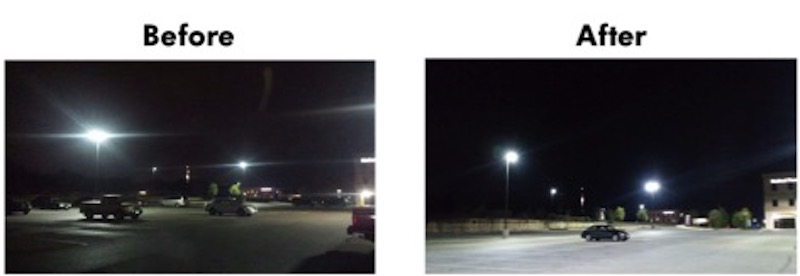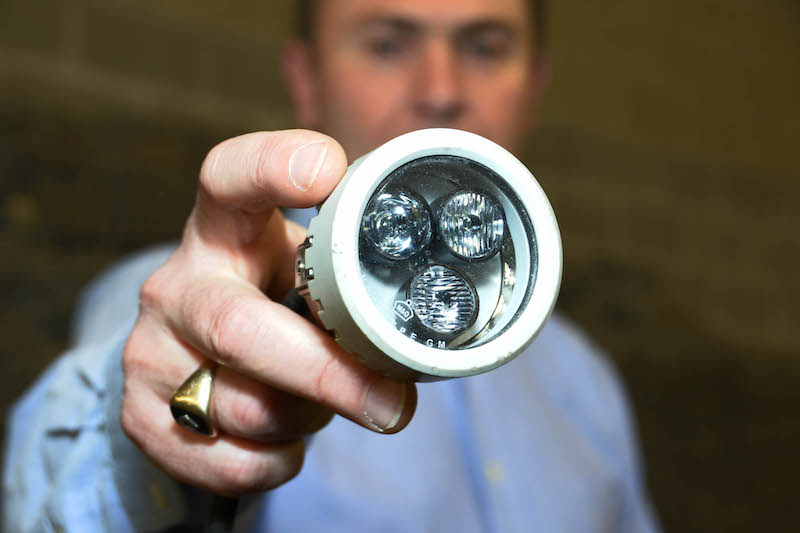As revenue and margin pressures continue to challenge the healthcare industry, new lighting technologies can offer much needed operational cost savings while improving safety and the patient experience.
Most healthcare facilities in the United States utilize various legacy lighting systems to provide necessary illumination of their parking garages, corridors, stairwells, and critical patient care areas. These systems in many cases are costly to maintain and account for a large portion of the utility spend due to poor energy efficiencies.
The Benefits of LEDs
Light Emitting Diode (LED) lighting technologies have matured into viable products for healthcare facilities. In the past five years, there has been a rapid improvement and availability of LED products as primary light sources in most facility applications. In comparison to traditional fluorescent lamps, LEDs offer many benefits:
● High efficiency (useful light output per unit of energy)
● Reduces electricity cost
● Less heat generated reduces air conditioning requirements
● Longer life (60% higher rated life than equivalent fluorescents)
● Lesser need for a patient disruptive lamp replacement
● Fewer lamp changes reduces patient Infection Control risk
● Easy plug and play retrofits
● Reuses existing light fixtures for lesser cost and disruption to hospital operations
● Rapid conversion to LED’s by simply replacing fluorescent lamps with LED lamp
● No appearance change to ceilings or fixtures after work is done
● Can reuse existing ballasts in most cases
● Environmentally friendly
● LEDs contain no toxic mercury - reducing lamp disposal costs
● Longer life reduces quantity of lamps needing disposal/recycling
● High efficiency reduces electricity generation greenhouse gas emissions
● Better lighting quality
● Enhanced safety due to better light distribution reducing shadowed areas
● Spaces appear brighter and more inviting
Exterior Lighting
Beginning in 2014, working with CHRISTUS Health System, we identified several key areas where new LED technologies had matured sufficiently to reliably and cost effectively offer significant benefits. After a return on investment (ROI) analysis, the areas that would benefit the most from LED installations were spaces requiring 24/7/365 operation with electricity costs of $0.07/kWh or higher. These filters identified parking garages and large parking lots as projects with the best ROI and energy reduction potential in excess of 70%.
CHRISTUS Health, located primarily in Louisiana and Texas, operates 20+ Acute Care and Critical Access hospitals. A review of the enterprise portfolio identified eight parking garages totaling more than 4.5 MSF that were viable candidates for an LED upgrade. These garages had a variety of existing lighting types including high pressure sodium, metal halide, and fluorescents, many at end of life, requiring frequent and expensive maintenance.
Implementation
With the project scope identified, Requests for Proposals (RFPs) were issued to five major lighting installation firms to quantify savings potential under market conditions and evaluate product recommendations. The result of this extensive review confirmed earlier estimates of a 70+% energy savings potential with ROIs in excess of 40%. The program was presented to Lance Mendiola, VP of Facilities Management and Construction for CHRISTUS Health and funding was approved. The retrofit work was completed within 90 days of funding.
The garage lighting retrofit program has been so successful that CHRISTUS Health received recognition from the Lighting Energy Efficiency in Parking (LEEP) committee (PNNL/DOE/BOMA). In June of 2015, CHRISTUS Health was presented two awards from the LEEP organizers for “Exemplary Parking Lighting Program in HealthCare” (only Healthcare provider recognized) and “Greatest Savings Realized at a Facility” for one site that exceeded 80% savings.

Interior Lighting
Building on the success of the 2014 Parking Garage LED program, attention was turned toward interior lighting. In 2015, a pilot program of 4,500 T8 LED retrofit lamps at the CHRISTUS St. Michael’s Hospital in Texarkana, TX and the CHRISTUS Hospital in Coushatta, LA was launched. The pilot program validated the ease of installation, quality of illumination, and energy savings while identifying the logistical requirements needed for an enterprise wide implementation. An effort to improve the ROI of the program was realized through the use of utility rebates (also used for the Parking Garage Program) that were available for this initiative.
A survey of the CHRISTUS hospital locations was conducted to determine the locations where the program would have the biggest impact. An immediate opportunity was identified to upgrade at least 35,000 T8 linear fluorescent lamps with the LED retrofit lamps. Always striving to maximize value, the lamp purchase was pooled with another large healthcare provider’s program. The combined purchase of 85,000 lamps offered significant discounts (>40%) that were passed on to the two participating clients.
The installation options considered for this program included both self-performed installation and/or using a specialized third party lighting installation company. Eventually, it was decided to use a third party installation company to replace the lamps in the hallways/lobbies and other easily accessible areas, while the in-house team would do the installations in the surgery and patient-care areas. This approach allowed for the project to be completed in the shortest time possible while also providing flexibility in the schedule to access critical and patient-care areas as needed.
The specifics of this program were used to develop a business plan that demonstrated annual savings of over $340,000 for an initial investment of $670,000. With the inclusion of $140,000 in utility rebates, this translated to a net payback of less than 1.6 years and ROIs of 60%. This proposal was presented to CHRISTUS Health who again saw the opportunity and approved the funding for additional projects. Total installation time for the 35,000 lamps was less than 90 days, not including the utility rebate inspections prior to and after the installation.
Upon completion of the interior LED lighting retrofit program, the results were submitted to the PNNL Interior Lighting Campaign committee for their evaluation. Upon their consideration and comparison to other lighting projects installed across the US, CHRISTUS Health was again recognized for their focus on energy efficiency with an “Exemplary Healthcare Sector Award”.

Conclusion
The lighting initiatives implemented by CHRISTUS Health will result in $686,000 in annual cost savings and 7,200,109 in electric kWh reduction which translates to 5,258 tons in CO2 emissions reduction or the equivalent of 1,167 cars taken off the road. For the next phase of the program, we are evaluating additional LED lighting technologies to extend the significant savings achieved in the first two years. Additional energy programs on the Supply side (negotiated energy contracts) and large scale HVAC retro-commissioning work have complemented and contributed significant additional cost savings to the overall effort. The financial and environmental benefits of this energy program support the stewardship value of CHRISTUS Health while also reducing their utility costs and improving their operating margins.
CBRE has partnered with CHRISTUS Health to provide outsourcing Facilities Management services and other related services since 2005. John Beck serves as the Alliance Director.
Related Stories
| Oct 13, 2010
Community center under way in NYC seeks LEED Platinum
A curving, 550-foot-long glass arcade dubbed the “Wall of Light” is the standout architectural and sustainable feature of the Battery Park City Community Center, a 60,000-sf complex located in a two-tower residential Lower Manhattan complex. Hanrahan Meyers Architects designed the glass arcade to act as a passive energy system, bringing natural light into all interior spaces.
| Oct 13, 2010
County building aims for the sun, shade
The 187,032-sf East County Hall of Justice in Dublin, Calif., will be oriented to take advantage of daylighting, with exterior sunshades preventing unwanted heat gain and glare. The building is targeting LEED Silver. Strong horizontal massing helps both buildings better match their low-rise and residential neighbors.
| Oct 12, 2010
Owen Hall, Michigan State University, East Lansing, Mich.
27th Annual Reconstruction Awards—Silver Award. Officials at Michigan State University’s East Lansing Campus were concerned that Owen Hall, a mid-20th-century residence facility, was no longer attracting much interest from its target audience, graduate and international students.
| Oct 12, 2010
Gartner Auditorium, Cleveland Museum of Art
27th Annual Reconstruction Awards—Silver Award. Gartner Auditorium was originally designed by Marcel Breuer and completed, in 1971, as part of his Education Wing at the Cleveland Museum of Art. Despite that lofty provenance, the Gartner was never a perfect music venue.
| Oct 12, 2010
Cell and Genome Sciences Building, Farmington, Conn.
27th Annual Reconstruction Awards—Silver Award. Administrators at the University of Connecticut Health Center in Farmington didn’t think much of the 1970s building they planned to turn into the school’s Cell and Genome Sciences Building. It’s not that the former toxicology research facility was in such terrible shape, but the 117,800-sf structure had almost no windows and its interior was dark and chopped up.
| Oct 12, 2010
Cuyahoga County Soldiers’ and Sailors’ Monument, Cleveland, Ohio
27th Annual Reconstruction Awards—Gold Award. The Cuyahoga County Soldiers’ and Sailors’ Monument was dedicated on the Fourth of July, 1894, to honor the memory of the more than 9,000 Cuyahoga County veterans of the Civil War.
| Oct 6, 2010
Windows Keep Green Goals in View
The DOE's National Renewable Energy Laboratory has almost 600 window openings, and yet it's targeting LEED Platinum, net-zero energy use, and 50% improvement over ASHRAE 90.1. How the window ‘problem’ is part of the solution.
| Oct 6, 2010
From grocery store to culinary school
A former West Philadelphia supermarket is moving up the food chain, transitioning from grocery store to the Center for Culinary Enterprise, a business culinary training school.
| Sep 30, 2010
Luxury hotels lead industry in green accommodations
Results from the American Hotel & Lodging Association’s 2010 Lodging Survey showed that luxury and upper-upscale hotels are most likely to feature green amenities and earn green certifications. Results were tallied from 8,800 respondents, for a very respectable 18% response rate. Questions focused on 14 green-related categories, including allergy-free rooms, water-saving programs, energy management systems, recycling programs, green certification, and green renovation.














